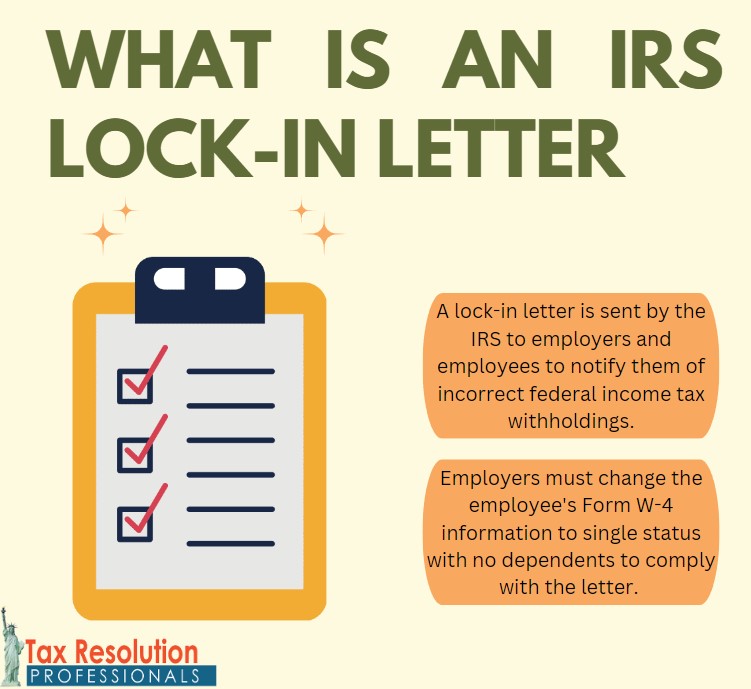What is a lock-in letter?
A lock-in letter serves as an official notification from the IRS regarding withholding compliance. It alerts both the employee and the employer that insufficient federal income tax has been withheld. The IRS issues two distinct notices:
- Letter 2800C: This is sent to the employer, indicating that the employee’s federal income tax withholding is insufficient. The letter specifies the revised withholding amount that the employer must implement moving forward. A copy of this letter is provided to the employee as well.
- Letter 2801C: This is sent directly to the employee, informing them that they are ineligible to claim exemption from federal taxes. An employee may also receive this letter if they claim more dependents than allowed.
Both letters direct employers to withhold federal income tax at a higher rate. Specifically, the IRS mandates that the employee’s filing status be set to single with zero dependents.
Once the lock-in rate is imposed, the IRS prohibits employers from reducing the employee’s withholdings. Additionally, if employees have electronic access to change their Form W-4, employers are required to block their ability to modify their withholdings.

Self-correcting letter
Before issuing the lock-in letter, the IRS typically sends a precursor letter known as the 2802C letter to employees. This letter serves as a self-correcting notice, informing the employee that their current withholdings are insufficient.
Upon receiving the 2802C letter, the employee should submit a new Form W-4 to rectify their withholding situation. The IRS suggests utilizing the IRS Tax Withholding Calculator to accurately complete the Form W-4 and adjust federal income tax withholding accordingly. Employers should then use the updated Form W-4 to increase the employee’s withholdings.
If the employee fails to provide a new Form W-4 following receipt of the 2802C self-correcting letter, the IRS proceeds to send a 2800C lock-in letter to the employer and a corresponding 2801C lock-in letter to the employee.
Types of lock-in letters
Upon receiving a lock-in letter from the IRS, you might be wondering about your next steps. As the employer, your responsibility lies in adjusting the withholdings according to the instructions provided in the notice. However, it’s important to note that the employee retains the option to appeal or modify their withholdings. Let’s delve into the distinctions among the various types of lock-in letters:
IRS Lock-in Letter 2800C: This letter directs you on how to amend an employee’s federal income tax withholdings. You have a 60-day window from the letter’s issuance date to implement the required changes. The notice provides specific instructions for adjusting the employee’s withholdings to ensure compliance. Additionally, a copy of the lock-in letter is included for your employee’s reference.
If the employee is no longer in your employ, no immediate action is necessary. However, it’s prudent to retain a copy of the letter for your records. Should the employee return within 12 months of the letter’s date, you must withhold income tax based on the filing status outlined in the lock-in letter.
IRS Lock-in Letter 2808C: In cases where the employee contests the lock-in letter and the IRS concludes that the employee is not obliged to file as single with no dependents, a 2808C letter is issued. Unlike the 2800C, the instructions provided in the 2808C are effective immediately, without the 60-day waiting period.
The 2808C letter informs you of the updated withholdings for the employee, which typically differ from those specified in the initial lock-in letter.
IRS Lock-in Letter 2801C: This letter is directed to the employee, notifying them that they’ve claimed an incorrect exemption status or exceeded the allowable number of dependents. Employees have the option to appeal directly to the IRS by requesting a modification to the notice. They have 30 days to appeal before the filing status specified in the letter becomes “locked-in.” Subsequently, you, as the employer, have an additional 30 days to adjust the employee’s withholdings.
It’s advisable to await the lock-in date mentioned in the letter before updating the employee’s withholding status. In the absence of an appeal, adjust the withholdings to reflect a single filing status with no dependents.
You may also facilitate the completion of a new W-4 form by the employee before making withholding adjustments. However, the withholding amount must be equal to or greater than the specified amount in the notice.
For instance, if the IRS lock-in letter mandates the employee to file as single with no dependents, the employee can submit a new Form W-4 with these parameters while opting for additional withholdings. However, they cannot choose a filing status with fewer withholdings, such as married filing jointly.
How to have a lock-in letter removed
To have a letter removed, employees must demonstrate consistent tax compliance over three consecutive years. Once this condition is met, they can request release from the lock-in. The IRS will then issue a 2813C letter to the employer, informing them of the employee’s release from the lock-in. Following this notification, the employee can submit a new Form W-4.
It’s crucial to note that once issued, the IRS withholding the letter cannot be removed outright; it can only be modified if the employee demonstrates compliance with the terms of the lock-in letter for three consecutive years.
What if you do not comply with a lock-in letter?
Failure to comply with a lock-in letter issued by the IRS, whether it’s the 2800C or 2808C, carries consequences. As an employer, it is imperative to adjust the employee’s withholdings as instructed in the letter. If you neglect to make these adjustments, you become liable for paying any additional taxes owed due to insufficient withholding. Therefore, non-compliance with the directives outlined in the lock-in letter can result in financial responsibility for the shortfall in taxes.
If you need help with your lock-in letter, dealing with tax debts, or both, call us at (888) 515-4829 or click here and fill out our intake form. If you are doing your case on your own, check out our free tax relief help guide.
For immediate help call (888) 515-4829 and we’ll assist you. You can also fill out the form below.
